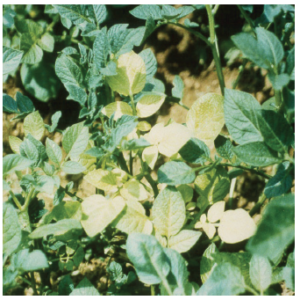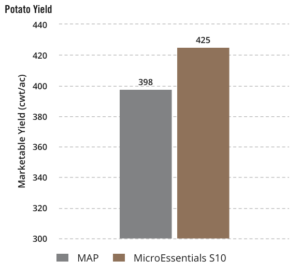OVERVIEW
- Phosphorus (P) management is a critical component of potato production systems and MAP is commonly used as a P source.
- Additionally, sulfur (S) has been shown to increase tuber yield and quality.
- MicroEssentials® S10® is a premium P fertilizer that provides uniform nutrient distribution, increased nutrient uptake, and two forms of S (sulfate + elemental) for season-long S availability.
Sulfur Deficiency in Potato

TRIAL DETAILS
Crop: Potato (Solanum tuberosum)
Years: 2017-2018
Locations: 10 trials across the US and Canada – ID, MB, MI, MN, ND, OR, WI
Data Source: Field studies conducted by independent third-party researchers.
Experimental Design: Small-plot RCBD with 4 replications.
TREATMENTS:
N Rate: Followed local recommendations.
P Rate: 80 lbs P₂O₅/ac as MAP or MicroEssentials® S10®
K Rate: 300 lbs K₂O/ac blanket applied across entire trial
Application Timing: Spring Preplant
Application Method: Broadcast incorporated
Results

SUMMARY
- The addition of a premium phosphate source containing two forms of S can increase marketable potato yield.
- Averaged across 10 site-years, MicroEssentials® S10® outperformed MAP by 27 cwt/ac.
- These results demonstrate the benefit of higher yield from key features of uniform nutrient distribution, increased nutrient uptake and season-long supply of S (sulfate + elemental).
- For more information, visit MicroEssentials – Performance.